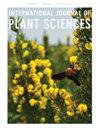Out of Africa to Madagascar—Then Back? Molecular Phylogenetics and Biogeography of Tribe Tarchonantheae (Asteraceae: Tarchonanthoideae)
IF 1.6
3区 生物学
Q3 PLANT SCIENCES
引用次数: 0
Abstract
Premise of research. Molecular data have revolutionized inferences of phylogenetic relationships and historical biogeography of flowering plants. Two small genera, Brachylaena and Tarchonanthus, are the only members of Asteraceae tribe Tarchonantheae (subfamily Tarchonanthoideae). The tribe is morphologically distinct within Asteraceae and is resolved as monophyletic with molecular markers. It is distributed in southern Africa and Madagascar. The purposes of the present study were to determine whether molecular data resolve the two genera as monophyletic and to infer the origin and dispersals that produced the current distribution of the tribe. Methodology. Sequences from the nuclear ribosomal ITS and ETS and plastid rpl16 intron were analyzed using maximum likelihood and Bayesian analyses to resolve phylogenetic relationships within the tribe. An ancestral trait reconstruction assessed the likely ancestral range for Tarchonantheae using BioGeoBEARS, and BEAST was used for dating divergence. Pivotal results. We resolved Tarchonanthus as a monophyletic group nested within Brachylaena, making the latter genus paraphyletic. All Malagasy species occurred within a strongly supported clade, but also resolved within the clade was the widely distributed African species Brachylaena huillensis. This indicates two dispersal events between Africa and Madagascar—either a single dispersal to Madagascar, followed by back dispersal to Africa, or two independent dispersals from Africa. Conclusions. Tarchonanthus is a monophyletic group nested within Brachylaena, rendering the latter genus paraphyletic. An initial dispersal of Brachylaena from Africa to Madagascar with subsequent speciation, followed by back dispersal to Africa, with minimal morphological divergence between the African species and its sister species in Madagascar could explain the current distribution of Brachylaena. Alternatively, there may have been two dispersal events to Madagascar from Africa during the Miocene, but all within the same subclade. Dispersal of flowering plants back to Africa from Madagascar is very rare, if not unprecedented. These dispersal events, and most diversification within the tribe, including the divergence of Tarchonanthus and Brachylaena, took place during the Miocene.从非洲到马达加斯加,然后再回来?石斛科石斛科石斛科分子系统发育与生物地理学
研究的前提。分子数据已经彻底改变了开花植物系统发育关系和历史生物地理学的推论。两个小属,Brachylaena和Tarchonanthus,是Asteraceae tribe Tarchonantheae (tarchonanideae亚科)仅有的成员。该部落在菊科中形态不同,并通过分子标记确定为单系。它分布在非洲南部和马达加斯加。本研究的目的是确定分子数据是否表明这两个属是单系的,并推断产生当前部落分布的起源和分散。方法。利用最大似然分析和贝叶斯分析分析了核糖体ITS和ETS以及质体rpl16内含子的序列,以解决部落内部的系统发育关系。祖先特征重建利用biogeobars评估了Tarchonantheae的可能祖先范围,并利用BEAST进行了年代划分。关键的结果。我们将Tarchonanthus分解为嵌套在Brachylaena内的单系类群,使后者成为副属。所有马达加斯加物种都出现在一个强大支持的进化支系中,但也解决了在进化支系中广泛分布的非洲物种Brachylaena huillensis。这表明在非洲和马达加斯加之间发生了两次分散事件——要么是一次分散到马达加斯加,然后又回到非洲,要么是两次独立的从非洲扩散。结论。Tarchonanthus是嵌套在Brachylaena中的单系群,使得后者属为副系。Brachylaena最初从非洲扩散到马达加斯加,随后形成物种,然后返回到非洲,非洲物种与其在马达加斯加的姐妹物种之间的形态差异很小,这可以解释目前Brachylaena的分布。另一种可能是,中新世期间可能有两次从非洲到马达加斯加的扩散事件,但都是在同一个亚分支内。开花植物从马达加斯加扩散回非洲是非常罕见的,如果不是史无前例的话。这些分散事件以及部落内部的大部分多样化,包括Tarchonanthus和Brachylaena的分化,都发生在中新世。
本文章由计算机程序翻译,如有差异,请以英文原文为准。
求助全文
约1分钟内获得全文
求助全文
来源期刊
CiteScore
4.50
自引率
4.30%
发文量
65
审稿时长
6-12 weeks
期刊介绍:
The International Journal of Plant Sciences has a distinguished history of publishing research in the plant sciences since 1875. IJPS presents high quality, original, peer-reviewed research from laboratories around the world in all areas of the plant sciences. Topics covered range from genetics and genomics, developmental and cell biology, biochemistry and physiology, to morphology and anatomy, systematics, evolution, paleobotany, plant-microbe interactions, and ecology. IJPS does NOT publish papers on agriculture or crop improvement. In addition to full-length research papers, IJPS publishes review articles, including the open access Coulter Reviews, rapid communications, and perspectives. IJPS welcomes contributions that present evaluations and new perspectives on areas of current interest in plant biology. IJPS publishes nine issues per year and regularly features special issues on topics of particular interest, including new and exciting research originally presented at major botanical conferences.

 求助内容:
求助内容: 应助结果提醒方式:
应助结果提醒方式:


